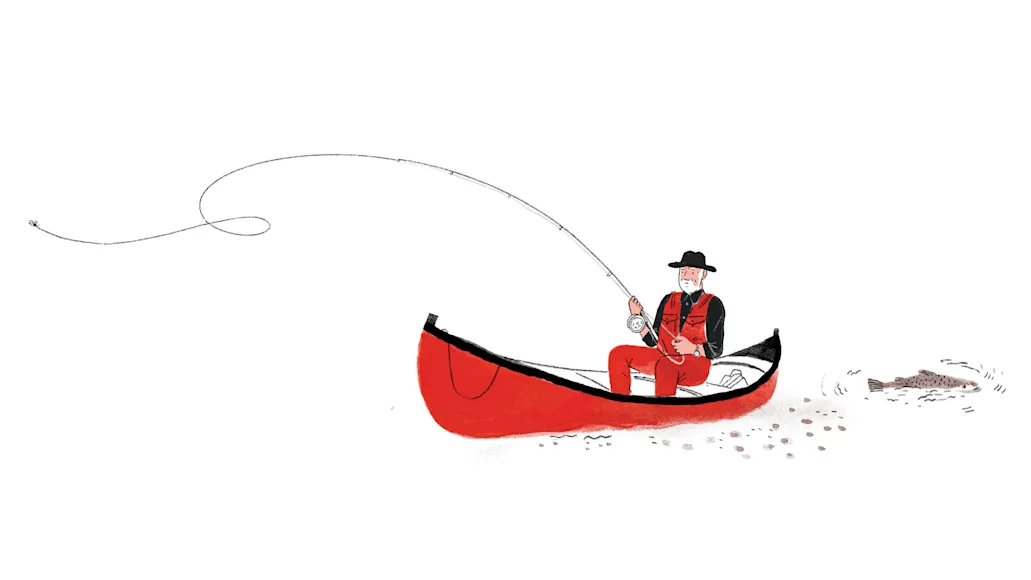BROWN ISN’T WORKING TODAY. Neither is white. Even orange on a green jighead isn’t getting bit. It’s a chilly sunny April day, and I’m out with Paula and Gordon in a Fletcher’s rowboat, bouncing tandem bucktail jigs for white perch. Every year the Potomac’s migratory species—shad, herring, and perch—swim up out of the Chesapeake Bay to spawn. Every year, the three of us go out to meet them. It’s how we mark the death of winter and the beginning of spring, the end and start of another circuit on the big merry-go-round. It’s how we honor the stupefying fact that all three of us are still alive to see it. No one says a word about any of this. That’s part of the ritual.
We’ve tried several historically productive holes, spots combining the deep water and rocky bottom that perch prefer. I got bit as soon as my rig hit bottom. Perch don’t really fight. There’s just a sudden quickening in your hands that tells of a fish on the line. I had a double on yellow jigs, two keeper fish. Gordon picked up an even bigger single on a brown jig and threw it in the cooler. But just as fast as we caught those fish, things went cold. Now he’s trying orange. Anglers like us fixate on color because it’s one of the few things we can control. But it doesn’t matter what you’re throwing if the fish aren’t there, so now we’re drifting, hoping to luck into a school.
“I’m not happy,” Paula announces. While this is no surprise, it’s also one of the great things about her. Unlike some people, Paula Smith never makes you guess her mood. She comes right out and tells you. Today she sports her standard field uniform: a black beanie under her Tilley hat, chin strap deployed against the gusty wind, a man’s green army coat, one of Gordon’s old shirts, jeans, and sneakers she probably fished out of a dumpster. “They gotta be here, you know?” she says to no one in particular. She’s covering her bets, one white, one purple. Once again, I ponder how this strange, gruff, almost filterless woman has become one of my oldest friends. It says more about me than her, I’m just not sure what. More Christmases than not, I have dinner with Paula and Gordon.
Paula shakes out a cigarette and lights it in a 20-knot wind on the first try. Soon we’re both smoking the cigarette. She sees my grimace and cackles. “You like these?” she asks, feigning a concern she clearly doesn’t feel. “New brand. No additives, lotsa nicotine. Just the way I like ’em, honey.”
Drifting isn’t producing either, so Gordon tells Paula to drop the anchor and pours a cup of coffee from his thermos. “Funny thing about climate change,” he says. “All the flowers and trees are blooming a month early, but the perch are coming a month later. Mid-April instead of mid-March. I checked my journals.” Seventy years ago, when Gordon was a boy, he could fill a 5-gallon bucket in a couple of hours. Now three anglers are lucky to get half that in an entire season. The netters downstream take them in huge numbers, and a lot of the fish we do catch—purple with a yellow collar is finally putting a few fish in the cooler—bear scars from nets. The perch look like they always do when you bring them up into the light—stunned at this bright world. Paula and Gordon subsist mostly on wild fish, waterfowl, deer, and the vegetables they grow out back. This is about putting fish in the freezer.
“How long we been fishing together, Paula?” I ask out of nowhere. “Twenty years?”
“No,” she scoffs reflexively, as if that can’t possibly be right. Then she reconsiders. “Well, maybe.” I think it’s more like 30 years. At least. Actually, I can’t think of a time when I didn’t know Paula.
We pull the anchor and motor downstream using the 2.5hp kicker Gordon bought after he sold his boat. At Windy Run, we start picking up a few. “That’ll work!” Paula crows when I pull up a double on purple jigs with a bit of Mylar flash in them. They’re both keepers. Paula’s using gaudy yellow jigs with a brown collar. Gordon is silently outfishing us both from the back of the boat. He’s throwing a green-and-yellow combo.
The old perch madness comes over us as the bite picks up. It’s abundance mania, the sudden, euphoric awareness of ripeness and plenty that must be gathered now. We don’t dare jinx it by talking. There is only the next fish and the next fish and the next fish, and the necessity of getting them efficiently, which means without haste.
In 10 minutes it’s over. We keep fishing but they’ve moved on. We’ve got maybe 25 keepers. A young bald eagle of no definite color flies overhead. “Good to see that,” Paula murmurs. It feels like an omen.
Back at the dock, I carry the little motor to Gordon’s truck. We take the oars and life jackets back to the boathouse. The fish go into a cooler. We carry our gear to the cars.
I ask, as I always do, if they don’t want some help cleaning the perch.
“Uh-uh, honey,” Paula says. “I’ve seen you fillet
, and it ain’t pretty. Come by the house sometime, and I’ll give you a packet of perch. If we have any left, I mean.” We nod to each other. They head out in Gordon’s truck.
And just like that, another year has begun.
_Read more F&S+
stories._






